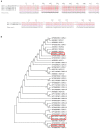Co-occurrence of Variants of mcr-3 and mcr- 8 Genes in a Klebsiella pneumoniae Isolate From Laos
- PMID: 31849875
- PMCID: PMC6887894
- DOI: 10.3389/fmicb.2019.02720
Co-occurrence of Variants of mcr-3 and mcr- 8 Genes in a Klebsiella pneumoniae Isolate From Laos
Abstract
Colistin is considered as a last resort antibiotic. The re-use of this antibiotic highlighted the emergence of colistin resistance mediated by chromosomal and plasmidic resistance mechanisms. Five colistin-resistant Klebsiella pneumoniae strains from Laos and Thailand were analyzed by Next Generation Sequencing (NGS) approaches to determine their colistin resistance mechanisms. Antimicrobial susceptibility testing, conjugation and transformation were performed on these strains. Moreover, whole genome sequencing (WGS) combining Illumina (MiSeq) and Oxford Nanopore technologies (MinION) was realized to obtain closed genomes and plasmids. Resistome analyses as well as location of mcr genes and its genetic environments were done in silico. All five strains had colistin MIC of 32 mg/L and were positive for mcr-3 variants including additionally positive for a mcr-8 variant gene. The novel variants were named mcr-3.21, mcr-3.26, mcr-3.28, and mcr-8.3 genes. The mcr-3 variants genes were located on plasmids IncP1, IncFII, and IncI1 type, while mcr-8.3 gene was found on an IncFII type plasmid. The genetic environment of mcr-3.21 and mcr-3.26 genes were composed of a composite transposon ISKpn40- mcr-3-dgkA- ISKpn40. Concerning mcr-8.3 gene, a similar genetic environment of mcr-8.1 gene surrounded by ISIX2 and IS903B was observed. To the best of our knowledge, this is the first description of the novel variants mcr-3.21, mcr-3.26, mcr-3.28 and mcr-8.3 genes as well as the first study on co-occurrence of mcr-3 and mcr-8 genes. Spread and evolution of mcr genes should be monitored.
Keywords: colistin; epidemiology – descriptive; mcr; resistance; whole genome sequencing.
Copyright © 2019 Hadjadj, Baron, Olaitan, Morand and Rolain.
Figures



References
-
- Bi D., Jiang X., Sheng Z.-K., Ngmenterebo D., Tai C., Wang M., et al. (2015). Mapping the resistance-associated mobilome of a carbapenem-resistant Klebsiella pneumoniae strain reveals insights into factors shaping these regions and facilitates generation of a ‘resistance-disarmed’ model organism. J. Antimicrob. Chemother. 70 2770–2774. 10.1093/jac/dkv204 - DOI - PubMed
LinkOut - more resources
Full Text Sources

